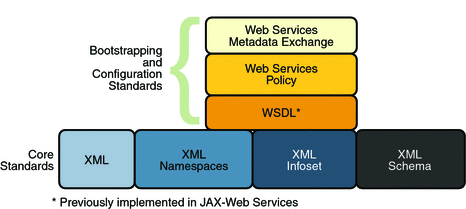Bootstrapping and Configuration Specifications
Bootstrapping and configuring involves a client getting a web service URL (perhaps from a service registry) and obtaining the information needed to build a web services client that is capable of accessing and consuming a web service over the Internet. This information is usually obtained from a WSDL file. Figure 2–3 shows the specifications that were implemented to support bootstrapping and configuration.
Figure 2–3 Bootstrapping and Configuration Specifications

In addition to the Core XML specifications, bootstrapping and configuration was implemented using the following specifications:
-
WSDL: The Web Services Description Language (WSDL) specification was previously implemented in JAX-WS. WSDL is a standardized XML format for describing network services. The description includes the name of the service, the location of the service, and ways to communicate with the service, that is, what transport to use. WSDL descriptions can be stored in service registries, published on the Internet, or both.
-
Web Services Policy: This specification provides a flexible and extensible grammar for expressing the capabilities, requirements, and general characteristics of a web service. It provides the mechanisms needed to enable web services applications to specify policy information in a standardized way. However, this specification does not provide a protocol that constitutes a negotiation or message exchange solution for web Services. Rather, it specifies a building block that is used in conjunction with the WS-Metadata Exchange protocol. When applied in the web services model, policy is used to convey conditions on interactions between two web service endpoints. Typically, the provider of a web service exposes a policy to convey conditions under which it provides the service. A requester might use the policy to decide whether or not to use the service.
-
Web Services Metadata Exchange: This specification defines a protocol to enable a consumer to obtain a web service’s metadata, that is, its WSDL and policies. It can be thought of as a bootstrap mechanism for communication.
- © 2010, Oracle Corporation and/or its affiliates
